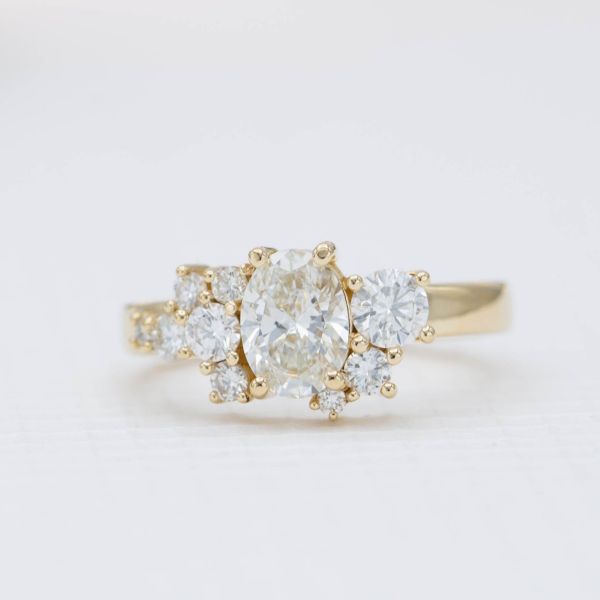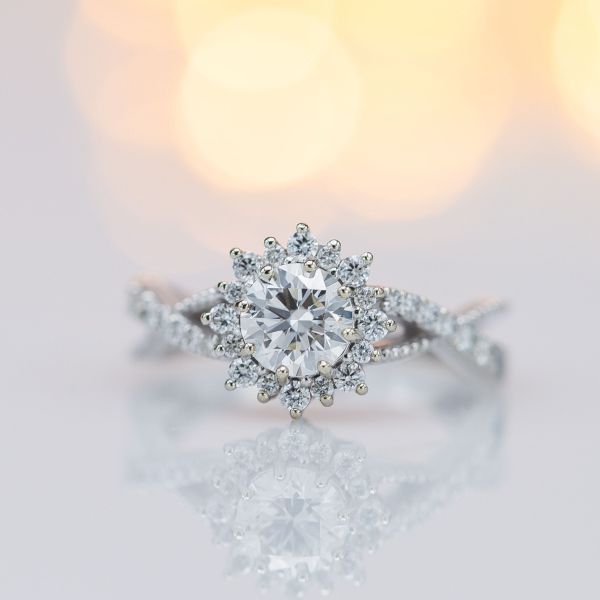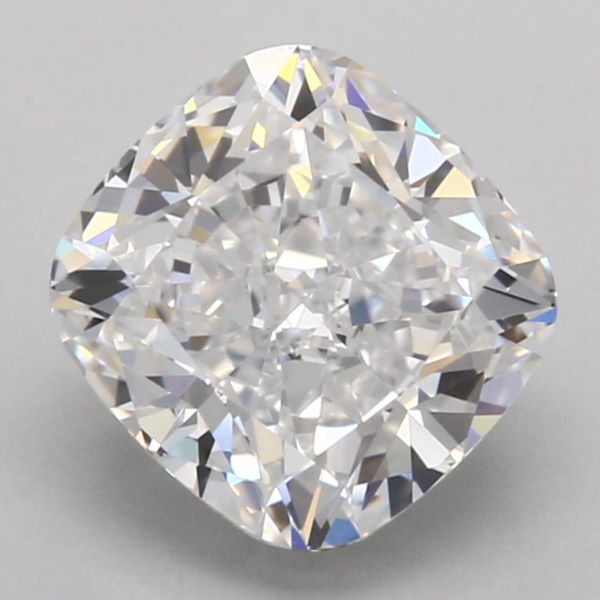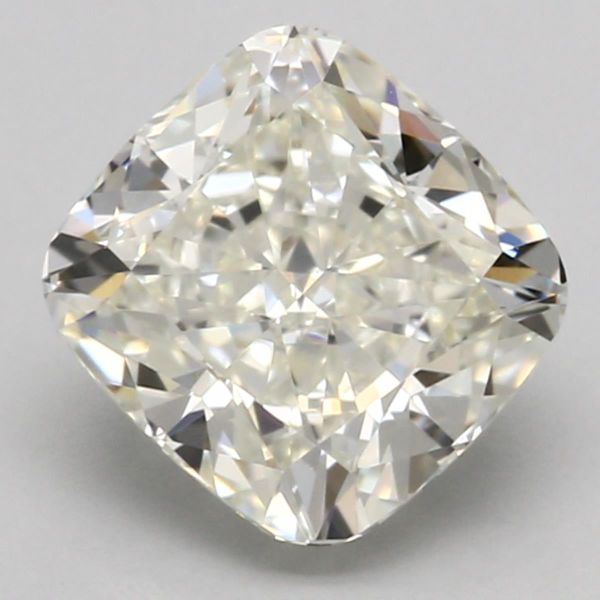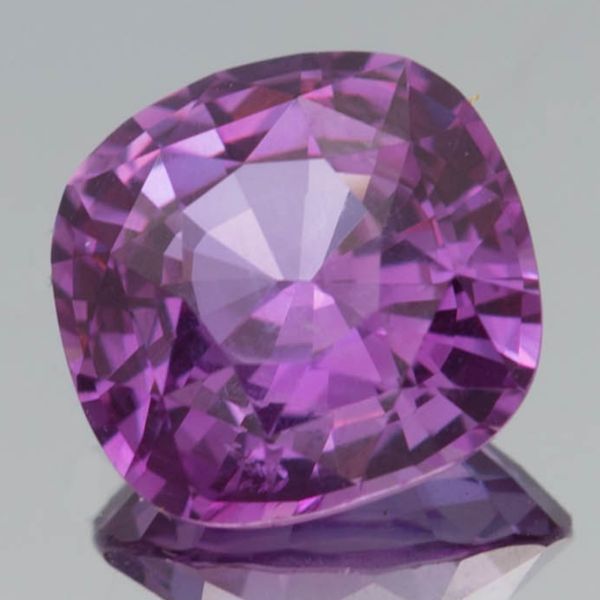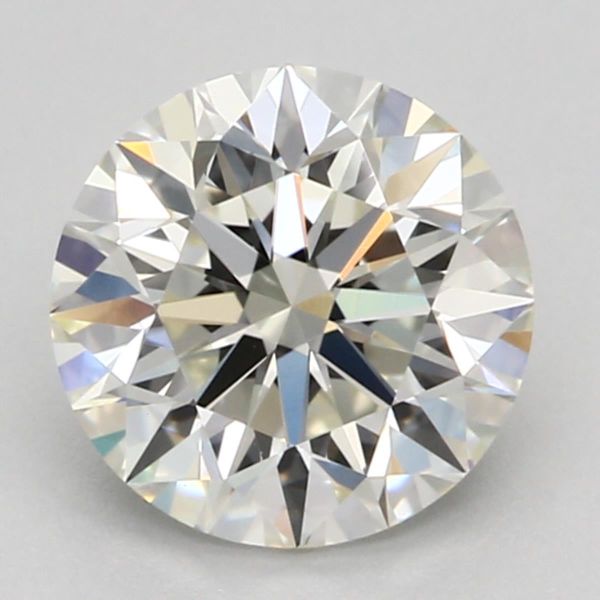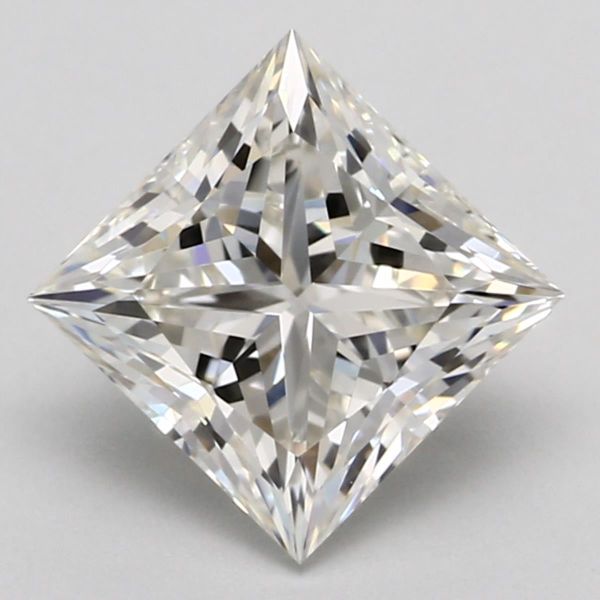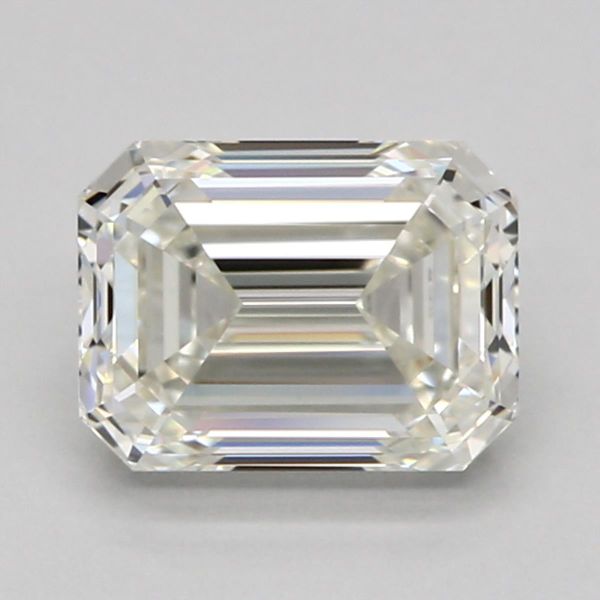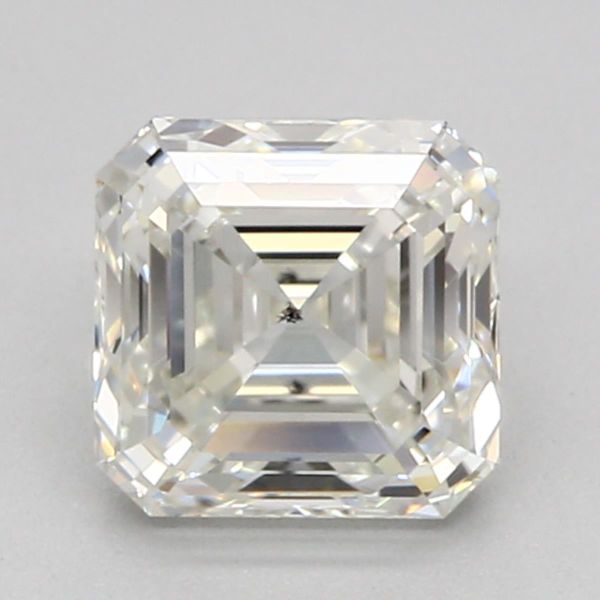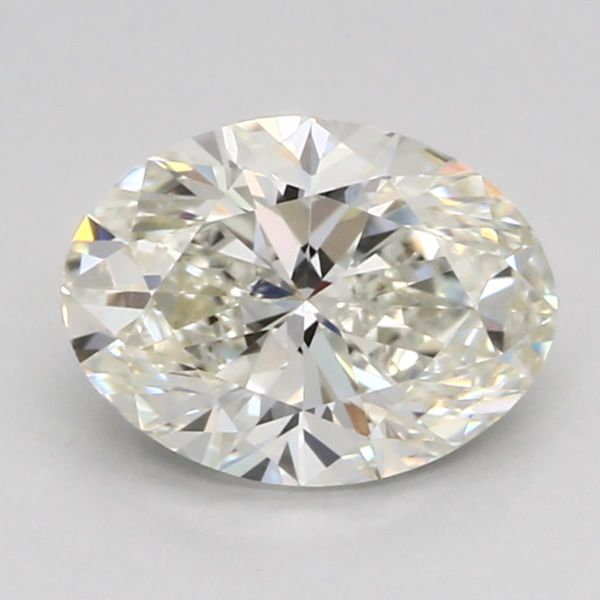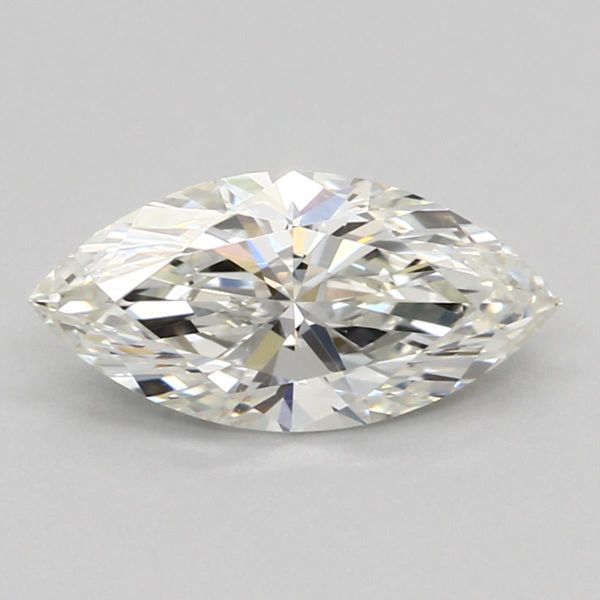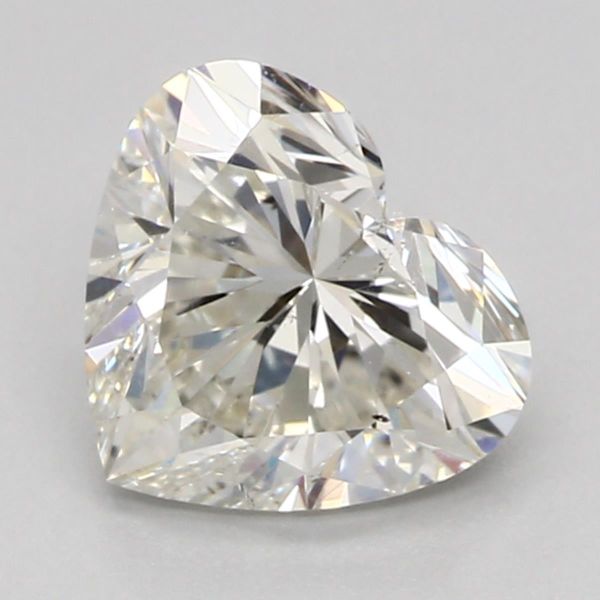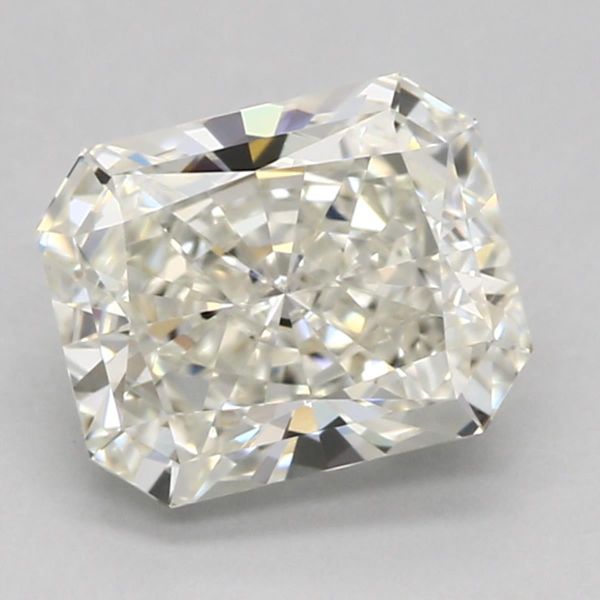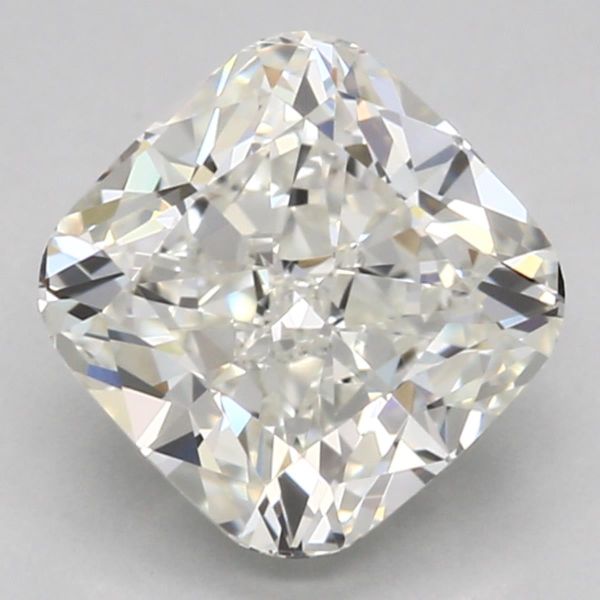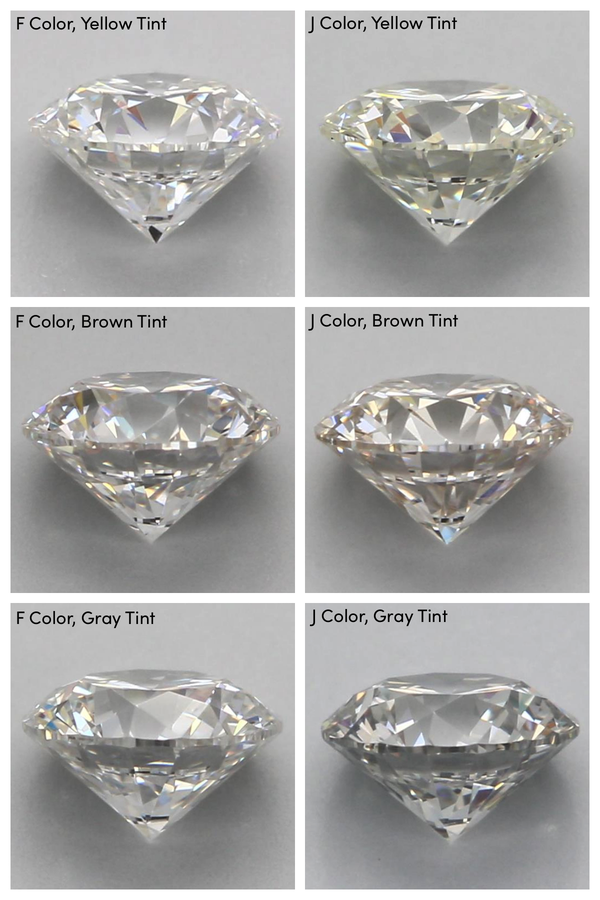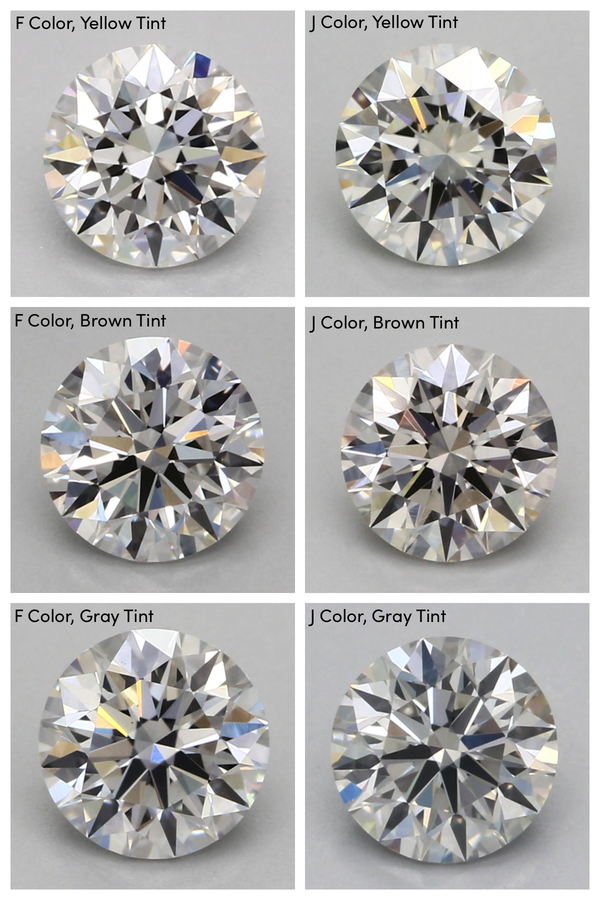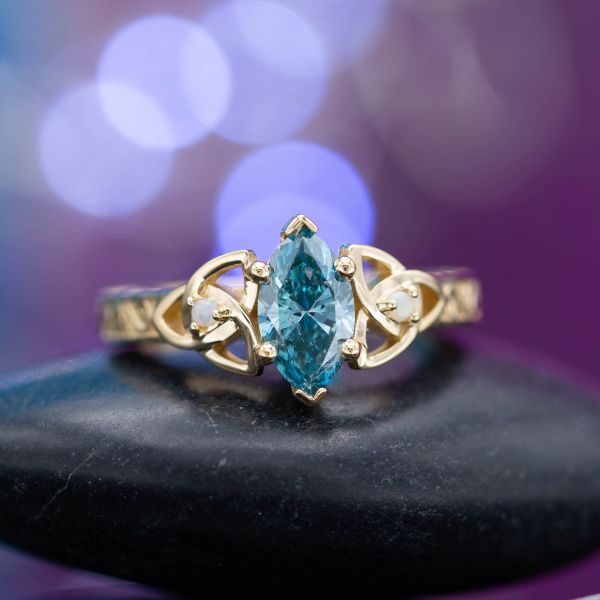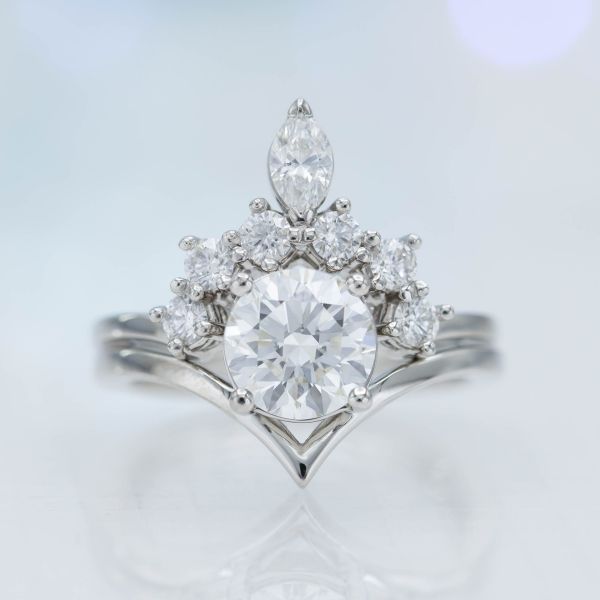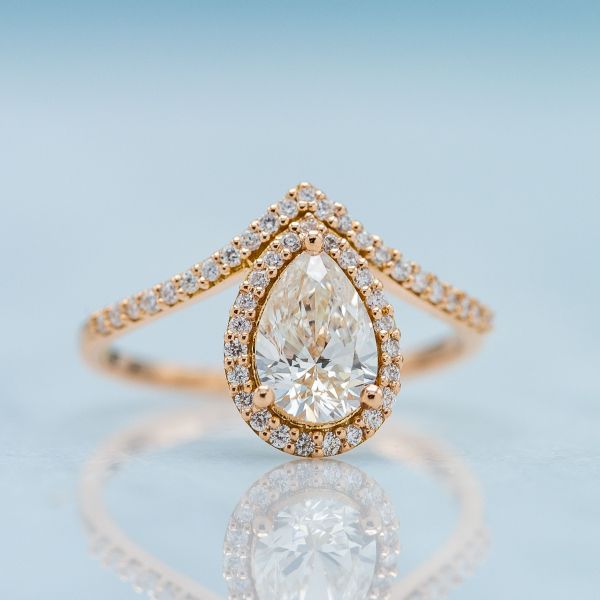Diamond Knowledge
Beyond the 4 Cs: Color
What do you need to know about a diamond's color grade?
This deeper dive into diamond color grading assumes some basic familiarity with diamonds and the 4Cs. If you haven't read it yet, we'd recommend you start with our overview of the 4Cs.
Overview
In our summary of the 4Cs, we introduced you to the idea that not all color grades are created equal. GIA’s D-Z scale provides a great foundation, but it doesn’t provide enough information on its own to determine if a diamond will look colorless in your ring. Two diamonds with the same color grade can display different color intensity, and the same diamond can look very different in two different rings. So let's dive deeper into the reasons why so we can explain how we apply our thinking to actual diamond purchases.
Some of the factors involved get pretty complicated, so we'll work our way from easiest to understand (the color of the metal in the setting) to hardest to understand (fluorescence). There’s a lot to cover, and we acknowledge, grudgingly, that not everyone is as obsessed with diamonds as we are. Feel free to jump to different sections, or to the end where we go over some examples of how we apply all these principles.
Metal color
Diamonds are designed to shine as much as possible. Similar to mirrors and polished metal, they reflect the colors of nearby objects. Any metal setting will provide reflection and hide the diamond's true color. That's why during grading, diamonds are viewed unmounted, on a white surface, under standard lighting. The reflections from yellow gold or rose gold prongs are substantial and at mild color tints, will hide the diamond's natural color. When setting a diamond in a yellow or rose gold setting, we typically recommend going a bit lower on the color scale to get the best value. There’s no need to pay for a top color grade because the metal’s reflection will make it impossible to appreciate the diamond’s colorlessness.
Diamond size
Large diamonds provide more for your eye to notice. They have larger facets and produce larger flashes of light. This makes it easier for your eye to pick up on any color tint. By contrast, smaller diamonds look like bundles of sparkle, revealing little about their underlying color. This means you can get away with lower color grades on smaller diamonds in a way that you can’t with larger stones. We recommend inching up to higher color grades for higher carat weights.
Accent diamonds
Diamonds are graded for color by comparison with other diamonds of known color grades. These points of reference allow the grader to accurately place the diamond's color intensity. Even a trained GIA grader wouldn’t be able to accurately identify a diamond’s grade without this standardization. The importance of comparison means that color tint is more noticeable in engagement rings with side accents and halos than it is in solitaire rings. If the accent diamonds in those rings have higher grades than the center, they can make a color-tinted center look yellower by comparison. This is particularly true because, as we mentioned previously, smaller diamonds tend to show their color a bit less than larger diamonds. To avoid this issue, diamond center stones should have color grades that match or exceed the surrounding melee.
Shape and cut affect perceived color intensity
Shape and cut change the way diamonds reflect light, so they change the way you perceive the color of a diamond. Diamonds are graded on their side to minimize this effect, isolating the true color of the stone. The problem is, the true color doesn’t determine what the stone will look like when it’s set face-up in your ring. For that, you need to understand the role of shape and cut.
To grade a diamond’s true color, grading laboratories like GIA set up highly controlled conditions. The diamond being graded is placed faced down and viewed from the side to eliminate the role of shape and cut. Standardized lighting is used, eliminating variance in lighting wavelength. From an accuracy perspective, this setup is great for understanding the extent of the color imperfections in the underlying material. Unless you’re a gemologist, you probably don’t care about that. You care about how the diamond looks when it’s set in your ring. Since diamonds are set face-up, shape and cut will play a critical role in how you perceive the diamond’s color. This is based on two main properties: the number of reflections and the amount of brilliance.
More reflections = more color
The longer a ray of light spends in the diamond before returning back to your eye, the less colorless it will look. That’s because the further the light has to travel, the more it interacts with the color-causing elements in the diamond. A ray of light traveling through a diamond containing nitrogen gets yellower and yellower the longer it spends in the diamond. That’s because more and more of the blue and violet wavelength light is getting absorbed by the nitrogen atoms in the diamond crystal structure. The more blue and violet light that’s removed, the stronger the yellow color.
Yellow in a diamond is caused by light hitting nitrogen atoms in the diamond crystal structure. Even a few nitrogen atoms for every million carbon atoms is enough to start causing a tint.
Cushion cuts are a good example of a shape that accentuates color. Their famous ‘crushed ice’ look is characterized by the appearance of many small scattered facets caused by light reflecting all around the stone. Lots of reflections mean a long path for light to travel within the diamond. This brings out the color, making cushion cut diamonds look more tinted than other shapes with the same color grade. This same property is an asset in colored gemstones where it enhances the intensity of the color. It’s no coincidence that cushion is a popular cut for sapphires, rubies, and other colored gems. As an example, take a look at the images below, showing just how much yellow tint is visible in a cushion cut diamond certified by GIA as an L color. And then take a look at the warm, rich purple of a cushion cut sapphire, whose color intensity is maximized by the cut.
More brilliance = less color
Brilliance is the intensity of white light return in the diamond. Intense white light dampens the visual impact of any colored light return by combining with and overpowering the colored light. Diamond shapes that return a lot of brilliance (e.g. round brilliant cut, princess cut) look whiter than those that don’t (e.g emerald cut, asscher cut). Also, well-cut diamonds look whiter than poorly-cut diamonds because their precise proportions mean more brilliance.
Breakdown for each shape
Now that we know the impact of brilliance (hides color) and reflection (enhances color), let's take a look at how those characteristics combine in some of the common gem shapes. Below, we've ranked how well each gem shape hides color tint. We've balanced the brilliance of the cut with the amount of reflection and ranked the cuts below according to how well that shape and cut will hide its color tint.
For each shape, we've included a picture of a J color diamond below, so you can get a sense of how much color is visible. But, if we're honest, the pictures don't tell the full story. Unfortunately, a still, zoomed image of a diamond will never capture exactly how the color will look when set in a ring — much of the light movement is lost, the camera and lighting setup can cause color variance, etc. So this is a case where we rely on the physics of each cut's light movement rather than our own eyes to give us a confident sense of what color grade will look colorless for each shape.
So, does that mean a cushion cut is a bad choice? Absolutely not! It just means that you can choose a lower color grade for a round brilliant and get a stone that appears colorless, but you'll want to select a higher color grade for a pear or a cushion cut, to ensure the same colorless appearance. It's also worth considering that shapes like pear cut, marquise cut, and oval cut may draw attention to the color tint by pooling more of the color in one part of the gem shape (e.g. near the points of the pear or marquise, or toward the ends of the oval). We take that into account when recommending a higher color grade for the shape.
Color undertones are not always yellow
The most common color undertone is yellow, followed by brown, and then gray. The undertone can also reflect a mix of these colors.
When explaining color, most jewelers refer only to yellow since it is by far the most common. That said, roughly 10-20% of the diamonds we see at wholesale have a brown or gray hue. That means that you’re reasonably likely to come across one during your search for a diamond. The difference in appearance and price of these alternate tints is substantial. It’s important to be aware of the tradeoffs so that you don’t unwittingly end up with a brown diamond when hunting for a good deal.
Color hue (yellow, brown, etc.) is not listed on GIA reports for diamonds with colorless or near-colorless grades (D-J). It is only listed for grades K-Z. If you are buying a colorless or near-colorless diamond, you will need to rely on the expertise of your jeweler to identify and disclose the color of the undertone.
How they differ
Let's start by taking a look at the 6 diamonds below. We'll show them all to you from the side, where you can get a sense of how the common color tints impact the appearance of the diamond. You can likely see the subtle but significant impact the tint has even at the "colorless" F color diamonds on the left — the diamonds with brown and gray tints don't look quite as bright and colorless as the yellow tint. And once you reach a J color, the distinction is even more visible — the yellow tint may be too strong for some, but the brown and gray tint are almost certainly too dark and will be unappealing to just about everyone.
With those examples in mind, let's talk about the different color tones in greater detail, and then we'll revisit those same 6 diamonds.
Yellow
Yellow is considered the most desirable undertone and commands the highest price. It is almost always caused by the trace presence of nitrogen in the carbon crystal structure. At higher color grades, our eyes perceive it as warmth, like an incandescent light or a cream color. Relative to other hues at a given color grade, it also absorbs the least light and appears the brightest.
Before the advent of the letter scale for diamond color grading, Faint - Light diamonds with a yellow tint were referred to as “cape” diamonds.
Brown
Brown is the second most common undertone. It is typically caused by graining imperfections in the crystal structure There is limited demand for brown diamonds, so they come at a steep discount. Based on the way GIA grades, brown diamonds appear darker than similarly graded yellow diamonds. We think this is an area where GIA’s grading system suits the needs of the grader better than the needs of the customer. J colored diamonds with a brown tint look like they have much more color than J colored diamonds with a yellow tint. Why do they get the same grade from GIA? Likely because it allows for clear spectrum from D-Z and brown diamonds get darker at the dark end. Still, we don’t think this decision is the best one for customers because it puts the brown diamonds in an odd position.
Unless you have a specific affinity for brown, we recommend avoiding brown diamonds altogether. Most customers find them to be less pretty and they add lots of confusion about pricing and grading.
A common distinction for diamonds among wholesalers is “No BGM,” which means no brown tint, no green tint, and no milkiness. These traits don’t show up on grading reports and are all considered major negatives for a diamond’s value, hence the frequent usage of the term. Green tint is most commonly found in diamonds from the Marange mines in Zimbabwe, which have a poor track record for working conditions. Similar to many other reputable jewelers, we boycott these stones. For examples of milkiness, check out our article on diamond clarity.
Gray
Gray is the third most common undertone. It’s considered darker and less desirable than yellow, but more desirable than brown. It can be caused by a number of factors, including the presence of hydrogen, the presence of boron, and quirks in the crystal structure. Certain customers have an affinity for its moody coolness, like a hint of a cloudy day. Similar to brown, we recommend avoiding gray tints unless this is something you know you want coming in. That said, if it is something that interests you, we’d be happy to help you find the right diamond!
Comparing yellow, brown, and gray undertones
Now that we've talked abut these common color tints, let's revisit the 6 example diamonds we showed you above. Take a look at those same diamonds from the front view:
Pretty hard to distinguish the color in the photos, isn't it? These photos are taken with a standard setup, as part of high resolution 360° videos from one of our trusted suppliers. And even with that standard setup, and with the labels on each diamond, it's a bit tricky to distinguish the true color from these diamond images. There's quite a bit of reflection, contrast, and other light effects happening in each diamond photo, which can obscure a bit of the color. But the color differences are significant, as we saw above! This is a good reminder to make sure you look at a diamond from all sides when you're choosing a center stone, and why you'll want to work with a trusted jeweler or supplier who can help point out subtle (but important!) differences like color tint.
Fancy colored diamonds
It's worth taking a moment to distinguish unwanted color from intentional color in diamonds. This article is focused on colorless diamonds, but some customers are looking for more color, not less. A grade of Z is the end of the colorless grading scale and the start of the fancy color grading scale. Rather than using a single color scale, fancy color diamonds are graded on three primary dimensions: hue, tone, and saturation. These combine to produce names like Fancy Intense Yellow and Fancy Deep Blue. Colored diamonds are beautiful and rare. If you’re interested in learning more, just ask us!
Fluorescence
One of the most confusing topics when it comes to diamond color is the role of fluorescence. There are many strong and often conflicting opinions on the subject. We've put together an overview on diamond fluorescence to help explain some of the debate. But our quick take is that the impact of fluorescence on the appearance of a diamond is relatively subtle. For those who prefer a completely colorless appearance in all lighting conditions, we generally recommend sticking with medium fluorescence or below. For those interested in a unique, somewhat hidden property that only comes out in UV light, a diamond with strong or very strong fluorescence can offer an interesting option, and one that can save you a bit on the diamond's cost.
Case studies
If you’ve made it this far, you’re probably convinced that there’s a lot to keep in mind when it comes to choosing a diamond with an appropriate color for your ring. To give you a sense of how we balance all these factors, we've outlined a couple examples of our thought process for diamond selection on actual rings.
Example 1
Our selection: 1.40ct G color Round Brilliant with G-H color diamond accents
Rationale: This customer wanted to create a ring that would turn heads, getting good value without any sacrifice on quality. G color provides savings relative to D-F, but is still a very safe choice for a round brilliant. Could we have gone lower in color grade? We looked at options in the H-J range (which can look beautifully colorless with a round brilliant), but with the customer's goal of a top-tier diamond, three factors pushed us to the higher grade:
- At 1.4cts, the diamond is large enough to show a bit more of its color.
- With accent gems on the matching wedding band, we want to choose accents that appear colorless, but are at or below the color of the center stone (to make it look even brighter and whiter). With a marquise in the accent diamond mix, we didn't want to go lower than an H for the accents.
- The platinum setting offers no color to "hide" any slight color tint.
To complement the center stone, we used G-H accent stones on the wedding band. And, as always, we made sure to avoid brown and gray undertones.
Example 2
Our selection: 1.01ct I color Pear Brilliant with I color accent diamonds
Rationale: On their own, I color pears show a noticeable mild tint in their point. However, in a rose gold setting like this, the yellow tint is concealed by the reflections from the rose gold setting. You can see from the image that the stone reflects the rose gold, but there isn’t really a hint of underlying color in the stone. Going with I color delivered significant savings and allowed us to get over 1ct while staying in the customer's budget. Not to mention that we fell in love with the shape and cut quality of this particular stone — not easy to find in a pear. We matched the center stone with I color accent diamonds in the halo, to make sure the halo didn't bring out any color tint in the center stone by comparison.
Conclusion
The basics of GIA’s color grading are easy to understand. The closer you are to a D grade, the less color there is in the diamond. Prices drop the further the color grade gets from D, but the expertise required to pick the right diamond increases. Like with clarity, you have two options:
- Pay up for a top color grade and play it safe, or
- Know your stuff and pay only for characteristics you can see
We recommend option 2 because the savings can be substantial. A 1ct D color round costs about twice as much as a 1ct J color round and you probably wouldn’t notice any difference between the two stones unless you compared them side by side. We understand you want to be sure your diamond looks great and that’s why we’re here. With a bit of expert guidance, you can get a great price and still feel confident your diamond will look perfect!
About CustomMade
CustomMade designs and creates one-of-a-kind, custom engagement rings and fine jewelry. Each piece we create is inspired by you, designed for you, and made just for you.

